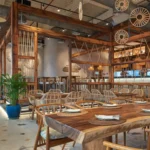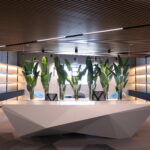Introduction
Embarking on an interior design project is an exciting journey filled with endless possibilities. From envisioning the perfect ambiance to witnessing it materialize, each step is crucial in bringing your dreams to life. In this article, we’ll delve deep into the intricacies From Vision to Reality in Interior Design Projects that is transforming your vision into reality, providing you with invaluable insights and expert advice every step of the way.
Understanding the Client’s Vision
Understanding the client’s vision is the cornerstone of any successful interior design project. By actively listening to their desires, preferences, and lifestyle requirements, designers can tailor their approach to create spaces that resonate with the client on a personal level. Through insightful conversations and detailed questionnaires, designers can uncover key insights that will inform every decision throughout the project.
Research and Inspiration Gathering
Before diving into the creative process, it’s essential to gather inspiration from various sources, including magazines, websites, and social media platforms. By staying abreast of the latest design trends and themes, designers can infuse fresh ideas into their projects while ensuring they remain relevant and timeless. Whether it’s incorporating elements of nature or embracing minimalist aesthetics, the possibilities are endless when it comes to finding inspiration.
Budgeting and Resource Allocation
Effective budgeting is essential for ensuring that your interior design project stays on track from start to finish. By establishing a clear financial plan upfront, designers can avoid unnecessary expenses and allocate resources wisely. From setting priorities to identifying cost-saving opportunities, meticulous budgeting lays the foundation for a successful and stress-free project.
Space Planning and Layout Design
Space planning is an integral aspect of interior design that focuses on optimizing the layout and flow of a space to maximize functionality and efficiency. By carefully considering factors such as traffic patterns, furniture placement, and spatial proportions, designers can create harmonious environments that cater to the needs of the occupants. Whether it’s reimagining a cramped kitchen or maximizing storage in a small bedroom, effective space planning is key to unlocking the full potential of any space.
Material Selection and Procurement
Selecting the right materials is paramount in achieving the desired look and feel for your interior design project. From luxurious fabrics to durable flooring options, each material choice plays a crucial role in shaping the overall aesthetic and atmosphere of a space. By sourcing high-quality materials from reputable suppliers, designers can ensure that their designs not only look stunning but also stand the test of time.
Design Development and Conceptualization
With inspiration in hand and materials at the ready, designers can begin the exhilarating process of bringing their ideas to life. Through sketching, rendering, and 3D modeling, designers can visualize their concepts in vivid detail, allowing clients to fully immerse themselves in the proposed designs. By iterating and refining their ideas based on client feedback, designers can ensure that the final design reflects the client’s vision while pushing the boundaries of creativity and innovation.
Implementation and Project Management
Once the design concept has been finalized, it’s time to roll up your sleeves and bring the vision to life. From coordinating contractors to overseeing construction, effective project management is essential for keeping the project on schedule and within budget. By maintaining open lines of communication and addressing any issues promptly, designers can ensure a smooth and successful implementation process from start to finish.
Final Touches and Styling
As the project nears completion, it’s time to add the finishing touches that will elevate the design to new heights. Whether it’s selecting the perfect accessories, layering textures, or adding pops of color, styling is where the magic happens. By infusing the space with personality and flair, designers can create environments that not only look beautiful but also feel inviting and lived-in.
Client Presentation and Feedback
With the design fully realized, it’s time to present the final concept to the client for approval. By walking the client through the design and highlighting key features, designers can ensure that the client feels confident and excited about the proposed changes. Additionally, soliciting feedback from the client allows designers to make any necessary adjustments or revisions to the design, ensuring that it meets their expectations and preferences.
Project Completion and Evaluation
As the project draws to a close, it’s essential to take stock of the journey and reflect on the achievements and lessons learned along the way. By celebrating successes and identifying areas for improvement, designers can continually refine their craft and deliver even better results in future projects. Whether it’s documenting the design process or gathering client testimonials, taking the time to evaluate the project ensures that valuable insights are captured and shared for future reference.
Conclusion
Embarking on an interior design project is not just about transforming spaces; it’s about transforming lives. From creating functional layouts to curating captivating aesthetics, every decision made along the way contributes to the realization of a vision. By following this step-by-step guide, you’ll be equipped with the knowledge and expertise to navigate every stage of your project with confidence and ease.
Frequently Asked Questions (FAQs)
Q: How long does an interior design project typically take to complete?
A: Interior design projects vary in duration depending on the scope and complexity of the project. However, a typical project can take anywhere from a few weeks to several months to complete, from initial concept development to final implementation.
Q: What factors influence the cost of an interior design project?
A: Several factors can influence the cost of an interior design project, including the size of the space, the level of customization required, the quality of materials selected, and the scope of work involved. Additionally, factors such as location, project timeline, and designer fees can also impact the overall cost.
Q: How involved will I be in the interior design process?
A: Client involvement in the interior design process can vary depending on personal preferences and project requirements. Some clients prefer to be highly involved in every decision, while others prefer to entrust the design process entirely to the designer. Ultimately, the level of client involvement is determined through open






